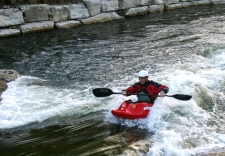[please login to make this ad block disappear]
Paddlers Urge Feds to Fund Urban River Revitalization
 This month, the Environmental Protection Agency in partnership with the White House Council on Environmental Quality, the Department of Agriculture and the Department of the Interior announced the funding of a $27 million project in Grand Rapids, Michigan.
This month, the Environmental Protection Agency in partnership with the White House Council on Environmental Quality, the Department of Agriculture and the Department of the Interior announced the funding of a $27 million project in Grand Rapids, Michigan.
"What started out as an idea for a couple of whitewater features has become a huge revitalization project for downtown Grand Rapids"
Local kayakers envisioned the project two years ago in the hopes of restoring the city's Grand River to its former glory.
The project began when two local paddlers, Chris Muller and Chip Richards, co-founders of the non-profit organization Grand Rapids White Water, contacted river engineering firm RiverRestoration in Carbondale, Colo., in the hopes of bringing the rapids back to their once great river. After months of planning and collaboration, the project expanded to include the removal of five dams, improvements to fisheries and restoring the aesthetic of the river for a holistic revitalization. "A group of local kayakers were the ones to initiate the project in Grand Rapids so they could improve their local paddling spot. Now it's part of a huge downtown redevelopment project with support from the Feds," said Backbone Media's Ian Anderson. This plan made the Grand Rapids project a perfect candidate for one of this year's eleven Urban Waters Federal Partnerships, designed to reconnect urban communities, particularly those that are overburdened or economically distressed, with their waterways. The program improves coordination among federal agencies and collaborating with community-led revitalization. "The Urban Waters designation is a major milestone for the Grand Rapids project," said RiverRestoration president and principal river engineer Jason Carey. "What started out as an idea for a couple of whitewater features has become a huge revitalization project for downtown Grand Rapids, with the support and resources of the federal government." "This project is a great example of a successful public-private partnership," adds Carey. "Working together with local, state and federal agencies, the revitalization of the Grand River through the city will have significant economic, environmental and social benefits." The rapids that gave the city its name began gradually disappearing in the mid-19th century during the city's industrial revolution. Throughout this period of development, the riverbed was quarried to provide stone for foundations; canals were cut into its riverbanks to generate power for sawmills; tree-covered islands were destroyed; the channel was dredged; and floodwalls and dams were built to regulate water levels. Today the stretch of the Grand River flowing through downtown Grand Rapids provides limited economic and recreational benefit to the city and its residents. In addition to improving the physical structure of the river and its banks, the restoration project has been designed to repair the natural habitats of various aquatic species. The plan will open the long cutoff Lake Sturgeon spawning grounds, diversify mussel beds, and enhance steelhead and salmon fishing. Aside from the project in Grand Rapids, the federal government has also awarded the projects with Urban Waters Federal Partnerships: Big River and Meramec River watersheds near St. Louis, Mo., Delaware River Basin that covers Philadelphia and Camden, N.J., Chester, Pa., and Wilmington, Del., Green-Duwamish River in Seattle, Mystic River watershed in Greater Boston, Martin Pena Canal in San Juan, P.R., Middle Blue River in Kansas City, Mo., Middle Rio Grande in Albuquerque, N.M., Passaic River in Newark, N.J., Proctor Creek watershed in Atlanta, and Western Lake Erie Basin near Toledo, Ohio. For more information on the Grand Rapids restoration project, visit grandrapidswhitewater.org |
Login to post here



























 Get for free:
Get for free: